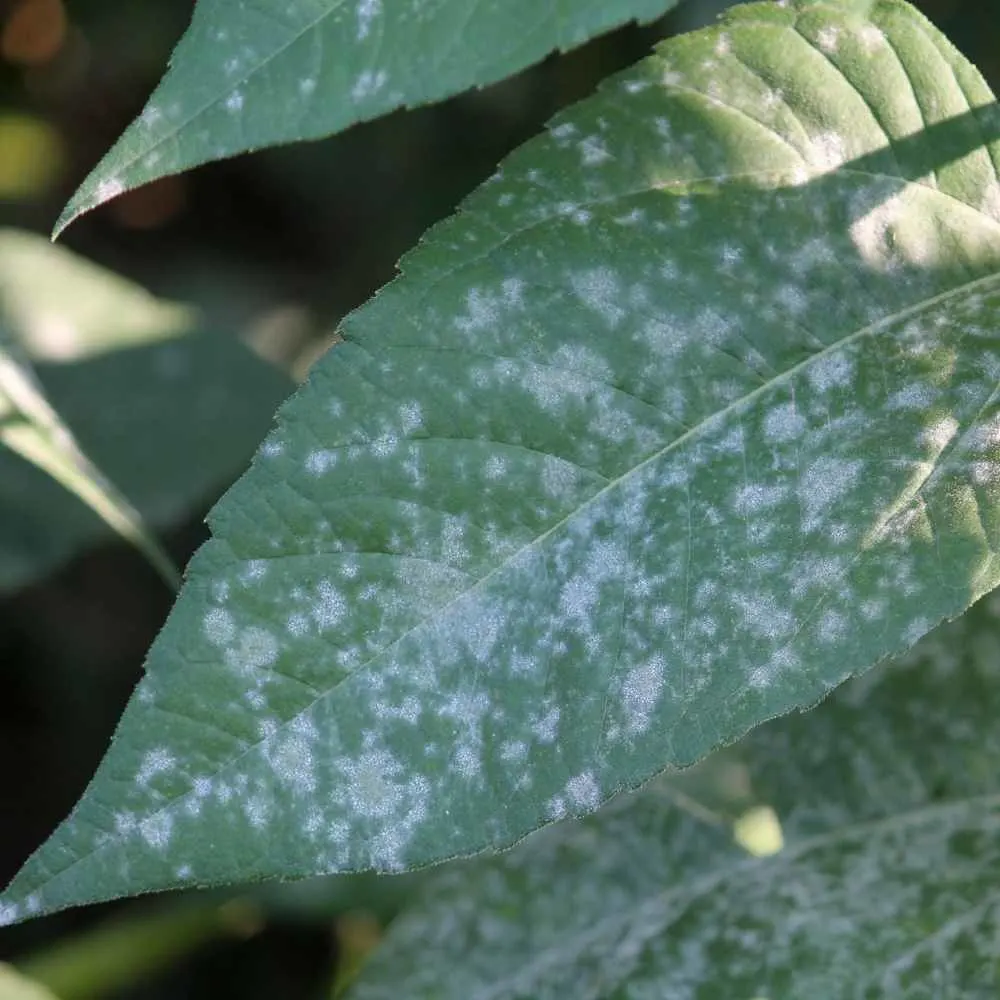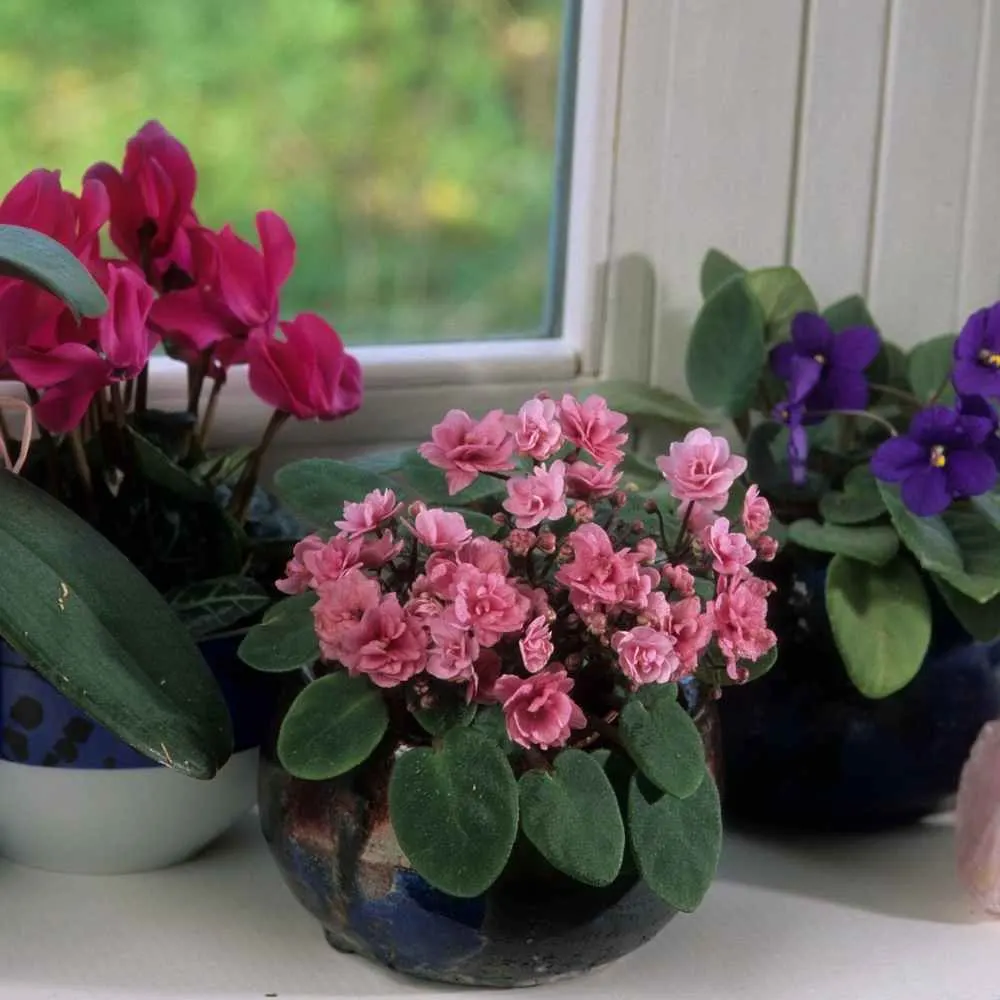Powdery Mildew ( Erysiphales family) on Plants begins as fuzzy yellow spots on leaves. As it grows, this mildew spreads into a white or grey mat covering leaves and stems. Learn how to get rid of powdery mildew with this treatment guide.
What Causes Powdery Mildew? Powdery mildew is spread by spores that germinate and thrive on their host plants. Stagnant air, humidity and warmth encourage mildews. When plants are closely packed together, mildews can get a foothold and thrive.
Powdery mildew fungus are a headache to both outdoors gardeners and indoor plant hobbyists. Some species of these fuzzy mildews enjoy highly humid conditions. Others require dry air. So wherever you are, there is probably a mildew willing to grow on your plants.
But keep in mind, Powdery mildews are parasitic. Which means they live by feeding on plant tissues. These mildews need particular host plants they can feed from.
There are 10,000 plants that can host mildews. Not all your plants will get powdery mildews since they cannot support them.
But many will.

Mildew probably won’t kill the plant. Most often it only grows on the plant leaf surfaces and feeds on the epidermis. This means the plant won’t be severely damaged unless the mildew is completely covering the plant.
When the leaves are heavily infested with mildew, The leaves lose the ability to photosynthesize. The mildew slowly ingests plant nutrients and harms the plants natural defenses. So the plant is weakened.
When to Treat Your Plants:
For lightly mildewed plants, you don’t need powdery mildew treatments. Prune the unsightly mildewed leaves off, dispose of the leaves carefully so you don’t contaminate other plants. And sterilize your pruners.
However, if after pruning, mildew continues to spread, you need to treat to control the mildew. Unfortunately, once the plant is covered in mildew, treatments are less likely to work to kill and contain the spread.
Treat your plants with a spray to kill mildew BEFORE it takes over your plants. Apply sprays when mildew has been pruned off to deter more spores from germinating on the leaves.

For leafy green garden plants like broccoli, or other agriculturally important leafy crops, like cannabis, the foliage is the product.
The commercial grower should focus on mildew resistant strains of commercially productive plants.
Prevention and good management are vitally important to prevent a major mildew outbreak that can destroy the salability of commercial crops.
In the home garden and greenhouse, Powdery mildews can affect the flavor of your fruits and veggies. It is important to control this mildew in your food crops before it destroys the plants usefulness.
For example, If you have a plot of squash with mildewed leaves… Can you eat Zucchini from a plant with powdery mildew? You can. However, if the plant is fully involved in powdery mildew the squash flavor may taste off.

Management and Treatments For Powdery Mildew:
Powdery mildew treatments and properly managed growing environments work together to deter powdery mildews.
Management-Best Practices to Deter Powdery Mildews:
Learn how to get rid of powdery mildew by managing your plants and their environment to deter molds and mildews.
- Provide air flow. Mildews love stagnate warm air. Deter molds and mildews using air circulation. For outdoor plantings and greenhouses make sure to keep enough space between trees, bushes, scrub and garden plants the air can flow through and around them. Indoors keep a fan circulating air around your plants and leave space between them. A slightly open windows and vents work well in warm air conditions.
- Reduce humidity around your plants.
- Add fans and vents in greenhouses and homes .
- Prune the lower foliage and all the mildewed leaves to open the plant to air. Sterilize your pruners before and after pruning.
- Water from the bottom of the plants to keep the soil and foliage less humid.
- In the garden and greenhouse use automatic watering hoses under the plants to keep foliage dry.
- Make sure your soil is well drained so it doesn’t hold a lot of water near the foliage.
- Mulch plants with wood chips or other organic mulch.
- Avoid Spraying the foliage of your plants when watering. Mildew doesn’t need water on the plants to germinate, but wet leaves can spread fungal diseases of all sorts.
- Avoid High nitrogen fertilizers that encourage new foliage. Powdery mildew is attracted to fresh young leaves.

If your plants still get powdery mildew on them with these best practices in place, it’s time to add the sprays.
Powdery Mildew Treatment Sprays:
How to Get Rid of Powdery Mildew with Organic Sprays:
Sprays and chemical treatments are the last line of defense to kill or deter a mildew. Sprays and chemicals are actually not as effective as good plant management, pruning and some tolerance of powdery mildews on plants.
However, if you catch the mildew early before it takes over the plant, these homemade fungicides and store-bought sprays will keep mildew from spreading.

Here are some well respected homemade and purchased treatments for powdery mildew.
- 1 Tablespoon (up to four) of Potassium Bicarbonate (amazon link) dissolved into water.
- 1 generous teaspoon of Bicarbonate of Soda (baking soda) and 1/2 teaspoon of castille soap to a quart of water.
- Milk diluted 40 to 60% with water is effective when sprayed in 10 day cycles.
- 1/2 Teaspoon neem oil (amazon link) mixed with 1/2 teaspoon non detergent soap like pure castille soap in a quart of water will deter mildew when sprayed on foliage every week or so.
- This liquid 811 Copper 4E fungicide spray is deemed safe for organic gardens, eatable foods and effective against powdery mildews when used as directed.
- sulpher fungicides like this one on amazon, are considered good organic treatments for mildews.
When applying treatments for powdery mildew Carefully examine all your plants and spray them if they show ANY small spots of mildew.
Be sure to apply the treatments to ALL the plant parts above the ground and use them regularly as directed.
Powdery Mildew In the Home:
For indoor plants, mildew is unsightly and can spread quickly among plants grouped together like African violets, begonias and other fuzzy leaved houseplants.
Look for leaves yellowing and wilting with fuzzy spots or a mildew coating on them. Powdery mildew is unsightly, reduces flowering and can spread to your other plants.

For houseplant parents, enjoying a mildew covered plant that is possibly contagious to other plants is a deal breaker.
Here’s how to get rid of powdery mildew in your home when a plant is fully covered.
- For any plant fully coated in mildew, the best method of dealing with it is to put the plant in a plastic bag tightly closed and dispose of it. DO NOT COMPOST INFESTED PLANTS.
- After plant removal, Wipe down the shelves, walls and windows with soap and vinegar to remove all the mold spores from surfaces.
- Allow the surfaces to dry well before adding more plants to the area.
- Do not put plants in an area that has mildewed plants without resolving the environmental conditions that are encouraging powdery mildew.
- Put in place our management suggestions listed above to discourage powdery mildew in future.
- Keep an eye on your plants and make sure to treat mildew by pruning it off or use a safe organic spray. Spray plants outdoors or in the shower if you can.
- If you’ve a collection of African violets or begonias, or other mildew loving plant groupies, they can all transfer powdery mildew to each other. Prune off the mildewed leaves and treat the whole collection of plants regularly until your are sure the mildew is not coming back .
NEVER compost plants with pests, molds and fungal infections. You will just spread these problems into your compost.
The Contented Plant
How to Get Rid Of Powdery Mildew-Summary:
Powdery mildews begin as spores driven to your plants on the wind. Once they find a hospitable plant with fresh young leaves, they attach, germinate and begin to feed.
Your first clue you have powdery mildew is seeing small fuzzy rounded spots on the leaves. If left untreated, it can spread over the entire plant top growth. If this happens it is best to safely dispose of the plant.
Following our best practices listed above along with judicious pruning, your plants will tolerate powdery mildew with little trouble.
If the mildew persists and spreads you will need to choose a homemade fungicide spray or purchase one listed here.
Powdery mildews are always in our environment. We learn how to get rid of them and tolerate a small mildew infestation on outdoor plants.
Indoor plants are a different matter. No one appreciates mildew on their houseplants. You will need to keep a close eye on your susceptible leafy house mates. Be ready to act if you see signs of powdery mildew.
These mildews are not the same as other white molds that live only on your potted plant soils or garden soils. Sapropytic Soil molds are harmless to your plants, but unsightly.
How to Get Rid Of Soil Molds

Follow Us:
Find us on YouTube, Instagram , Pinterest and TikTok! We love to Plant chat. We also comment, like and occasionally share your content to our daily stories. We’d love to see your plants. Share your joy in your houseplants. Happy Planting!
Last Posts:
- 5 Fantastic Cactus Species for Your Home
- Pygmy Date Palm Trees
- Bromeliad Care Guide and Profile
- Growing Gloxinia Plants in Your Home
- Staghorn Ferns Care and Maintenance
Related Content:
references
- For more information on Mildew in the flower garden here is a good article by the University of Minnesota
- Farmer Almanac-Powdery Mildew


Tips on how to build a pollinator garden - The Contented Plant
Tuesday 19th of April 2022
[…] How to Get Rid of Powdery Mildew on Plants-Treatment Guide […]
Murdannia Loriformis-The Bright Star Plant - The Contented Plant
Friday 15th of April 2022
[…] How to Get Rid of Powdery Mildew on Plants-Treatment Guide […]